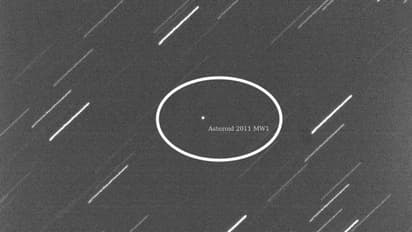Building sized asteroid captured by India's pioneering robotic telescope 'GROWTH-India' in Ladakh

Synopsis
The GROWTH-India telescope, stationed in Hanle, Ladakh, captured an image of a building-sized asteroid during its closest approach to Earth, at a distance ten times that of the Moon. Developed by IIA and IIT Bombay, this fully robotic telescope specializes in time-domain astronomy, tracking transient events within 24 hours of discovery.
The GROWTH-India telescope, stationed at the Indian Astronomical Observatory in Hanle, Ladakh, recently captured an image of a building-sized asteroid during its closest approach to Earth. A 0.7-meter wide-field telescope, developed through a collaboration between the Indian Institute of Astrophysics (IIA) and IIT Bombay, observed the asteroid as it journeyed across the sky, at a distance ten times that of the Moon.
Varun Bhalerao, an astrophysicist at IIT Bombay's Space Technology and Astrophysics Research (STAR) lab, shared the image on social media. "Last night, the GROWTH-India Telescope caught this 116m, building-sized asteroid on its closest approach to Earth! We tracked the rapid motion of the asteroid as it zipped across the sky at just 10x lunar distance. The rapid motion makes background stars look like streaks." Bhalerao posted on X (formerly Twitter).
Crimson glow of Ladakh's aurora: Giant telescope's May 10 time-lapse video reveals celestial spectacle (WATCH)
The GROWTH-India telescope stands as India's first fully robotic optical research telescope. It was developed through a collaboration between the IIA and IIT Bombay, with support from the Department of Science and Technology’s Science and Engineering Research Board (DST-SERB) and the Indo-U.S. Science and Technology Forum (IUSSTF). The current operations are funded by IIT Bombay's 1994 alumni batch, reported TOI.
The primary focus of the GROWTH-India telescope is time-domain astronomy, which involves studying explosive transients and variable sources in the universe. For this purpose, the telescope needs to start observations within the first 24 hours of discovering a transient event. Due to the often unknown precise positions of these new sources, the telescope requires a wide field of view for effective imaging.
Stay updated with the Breaking News Today and Latest News from across India and around the world. Get real-time updates, in-depth analysis, and comprehensive coverage of India News, World News, Indian Defence News, Kerala News, and Karnataka News. From politics to current affairs, follow every major story as it unfolds. Get real-time updates from IMD on major cities weather forecasts, including Rain alerts, Cyclone warnings, and temperature trends. Download the Asianet News Official App from the Android Play Store and iPhone App Store for accurate and timely news updates anytime, anywhere.